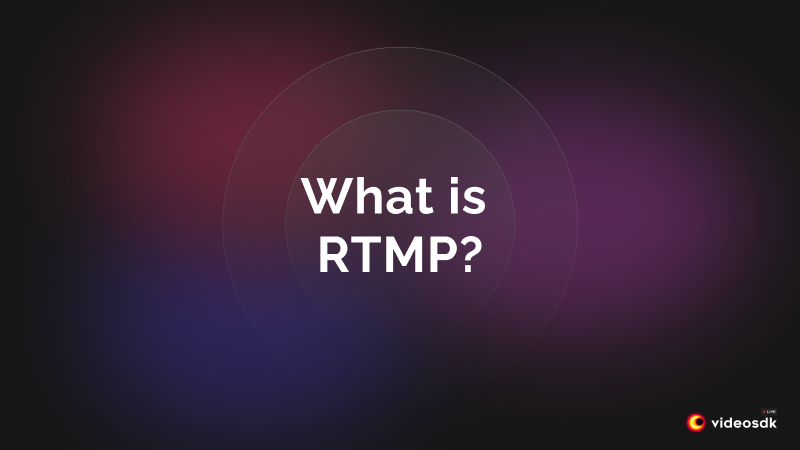What is RTMP (Real Time Messaging Protocol)?
Real time Messaging Protocol (RTMP) is a robust real-time communication protocol designed for real-time transmission of audio, video, and data over the internet. It facilitates low-latency streaming by maintaining a persistent connection between the server and the client. RTMP is widely used in live streaming applications, online gaming, and other scenarios requiring instantaneous data delivery for an immersive user experience.
Key Features of RTMP
RTMP boasts several key features that contribute to its popularity in the streaming landscape. These include low latency streaming, adaptive bitrate streaming, and support for various content types. In comparison to other streaming protocols, RTMP offers unique advantages that cater to the demands of different applications and use cases.
RTMP vs. Other Streaming Protocols
While various streaming protocols exist, Real-Time Messaging Protocol holds its ground due to its distinctive features. A comparison with other protocols, such as HTTP Live Streaming (HLS) and Dynamic Adaptive Streaming over HTTP (DASH), reveals the strengths and weaknesses of RTMP in different scenarios.
How Does RTMP Work?
Real-Time Messaging Protocol Architecture and Components
RTMP Server: At the core of RTMP communication is the RTMP server, responsible for managing client connections, handling streaming requests, and facilitating the transfer of multimedia data.
RTMP Client: The RTMP client, typically embedded in applications or devices, establishes a connection with the RTMP server to send or receive audio, video, or data streams.
RTMP Streams: RTMP streams are the channels through which multimedia content flows between the server and the client. These streams play a crucial role in delivering a seamless and uninterrupted streaming experience.
The RTMP Streaming Process Explained
Handshake Phase: The RTMP communication begins with a handshake phase, where the client and server exchange information to establish a secure and reliable connection.
Command Phase: During the command phase, the client and server exchange commands, enabling the client to request specific actions or stream-related tasks.
Data Phase: In the data phase, the actual streaming data, including audio and video content, is transmitted between the client and server in real time, ensuring a smooth streaming experience.
Benefits of Using RTMP for Live Streaming
Low Latency Streaming: RTMP's low latency capabilities make it suitable for applications where real-time communication and interaction are crucial, such as live gaming and virtual events.
- Adaptive Bitrate Streaming: The adaptive bitrate streaming feature ensures a smooth viewing experience by adjusting the quality of the stream based on the viewer's internet connection, device, or other factors.
- Support for Various Types of Content: RTMP supports a wide range of multimedia content, making it versatile for applications beyond traditional video streaming, such as audio streaming and data transmission.
- Easy Integration with Different Platforms: RTMP's compatibility with various platforms simplifies integration, allowing developers to incorporate it seamlessly into web and mobile applications.
RTMP's Impact on Audio-Video Conferencing
The Real-Time Messaging Protocol's role in facilitating real-time communication cannot be overstated. Whether powering audio-video conferencing or live streaming experiences, RTMP is the backbone of platforms that prioritize seamless user interactions. VideoSDK, a leading player in the field, harnesses the capabilities of RTMP to elevate the streaming experience.
Enhancing Streaming with VideoSDK and RTMP
What is VideoSDK
VideoSDK is a leading provider of real-time audio and video SDKs for every developer across the USA & India. With real-time audio-video SDKs, VideoSDK empowers developers with unparalleled flexibility, scalability, and control, making it effortless to integrate audio-video conferencing and interactive live streaming into web and mobile apps.
Features and Benefits of Integrating VideoSDK
- High-Quality Video Streaming: VideoSDK ensures high-quality video streaming, enhancing the overall viewing experience for end-users.
- Customization Options: Developers can tailor the RTMP streaming experience with VideoSDK's customization options, allowing for a personalized and branded interface.
- Real-Time Analytics: VideoSDK provides real-time analytics, empowering content creators and platform owners with valuable insights into viewer engagement and streaming performance.
Benefits of Using VideoSDK with Real-Time Messaging Protocol
VideoSDK, in synergy with RTMP, offers enhanced audio-video quality and stability. Developers benefit from a streamlined integration process, and customization options ensure a personalized user experience. The combination of VideoSDK and RTMP is a game-changer in delivering high-quality streaming solutions.
Have questions about integrating RTMP? Our team offers expert advice tailored to your unique needs. Unlock the full potential—sign up now to access resources and join our developer community. Schedule a demo to see features in action and discover how our solutions meet your streaming app needs.
Real-Time Messaging Protocol FAQs
1. Does VideoSDK support RTMP?
Yes, VideoSDK fully supports (Real-Time Messaging Protocol), providing developers with the capability to seamlessly integrate real-time audio-video streaming into their web and mobile applications.
2. Can I use VideoSDK with popular frameworks like React or JavaScript?
Absolutely! VideoSDK is designed with flexibility in mind. It offers support for popular frameworks, including React, JavaScript, Flutter, React Native Android, and IOS. This ensures that developers can leverage their preferred frameworks while incorporating powerful audio-video features.
3. How easy is it to integrate VideoSDK into my existing application?
Integrating VideoSDK is designed to be user-friendly. With comprehensive documentation and code examples, developers can follow a step-by-step process to smoothly integrate VideoSDK into their web or mobile applications.
4. Does VideoSDK support cross-platform development for both iOS and Android?
Yes, VideoSDK is built to support cross-platform development. Developers can use VideoSDK to add real-time audio-video capabilities to both iOS and Android applications, ensuring a consistent experience across platforms.
5. How does VideoSDK ensure security during the integration process?
Security is a top priority for VideoSDK. The integration process includes robust authentication mechanisms and encryption protocols to safeguard audio-video communication, providing a secure environment for users.
